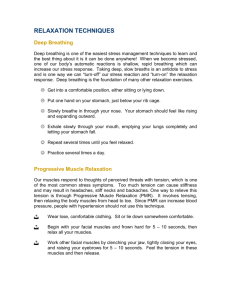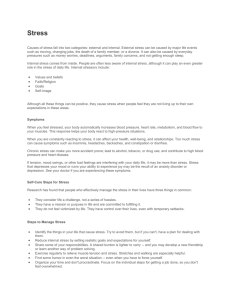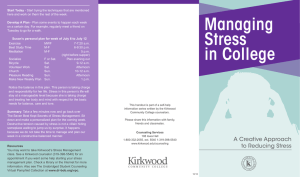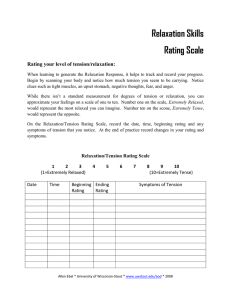Stress
advertisement
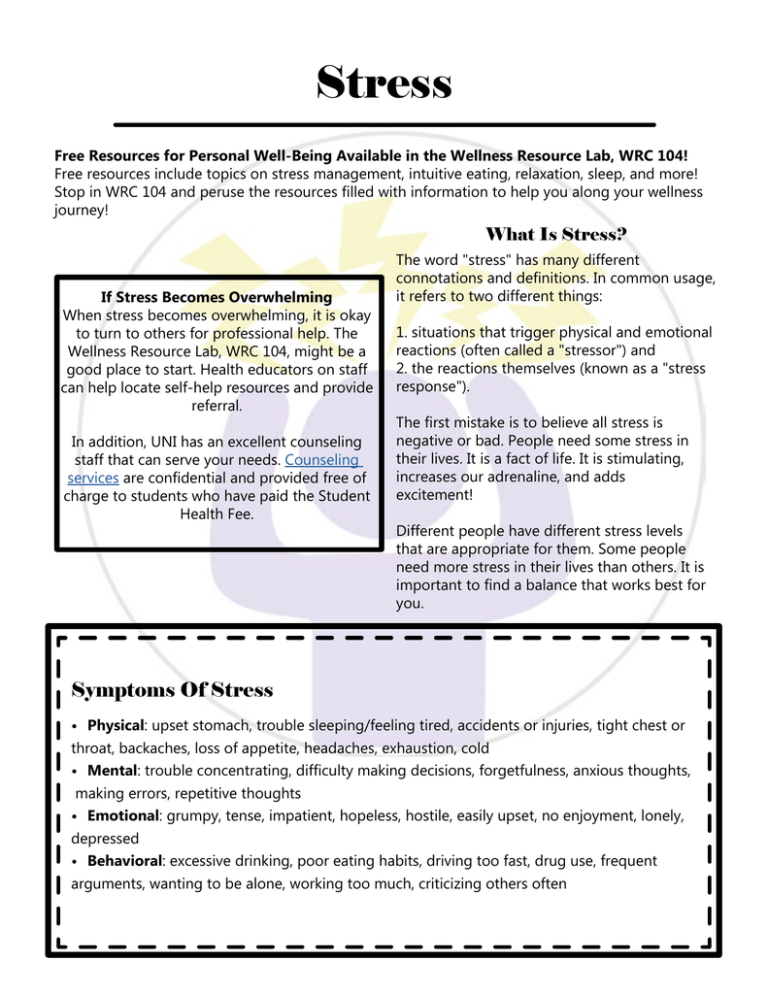
Stress Free Resources for Personal Well-Being Available in the Wellness Resource Lab, WRC 104! Free resources include topics on stress management, intuitive eating, relaxation, sleep, and more! Stop in WRC 104 and peruse the resources filled with information to help you along your wellness journey! What Is Stress? If Stress Becomes Overwhelming When stress becomes overwhelming, it is okay to turn to others for professional help. The Wellness Resource Lab, WRC 104, might be a good place to start. Health educators on staff can help locate self-help resources and provide referral. In addition, UNI has an excellent counseling staff that can serve your needs. Counseling services are confidential and provided free of charge to students who have paid the Student Health Fee. The word "stress" has many different connotations and definitions. In common usage, it refers to two different things: 1. situations that trigger physical and emotional reactions (often called a "stressor") and 2. the reactions themselves (known as a "stress response"). The first mistake is to believe all stress is negative or bad. People need some stress in their lives. It is a fact of life. It is stimulating, increases our adrenaline, and adds excitement! Different people have different stress levels that are appropriate for them. Some people need more stress in their lives than others. It is important to find a balance that works best for you. Symptoms Of Stress • Physical: upset stomach, trouble sleeping/feeling tired, accidents or injuries, tight chest or throat, backaches, loss of appetite, headaches, exhaustion, cold • Mental: trouble concentrating, difficulty making decisions, forgetfulness, anxious thoughts, making errors, repetitive thoughts • Emotional: grumpy, tense, impatient, hopeless, hostile, easily upset, no enjoyment, lonely, depressed • Behavioral: excessive drinking, poor eating habits, driving too fast, drug use, frequent arguments, wanting to be alone, working too much, criticizing others often Identifying Stressors Take a moment to think about the stressors in your life. Sometimes it helps to identify what they are so we can begin to relieve stress before it warrants medical attention! Common Stressors Among College Students Financial problems Excessive drinking Poor roommate dynamics Health problems Not enough sleep or exercise Change in eating habits Relationship issues Time management Working too much No quiet or alone time Conflict at job Family conflicts Sexual problems No one to talk to Technology frustrations Scholarships Tests Increased academic workload Declare/change of major Ways To Relieve Stress Get more sleep Journal Make time for you Eat a well balanced diet Cry Exercise Ask for help if you need it Simplify Allow time for things you enjoy Practice gratitude Play with an animal Practice yoga Visit the WRC Take a break to stretch Laugh Read a good book Watch a movie Take a vacation Call a friend Prioritize tasks Take Charge Of Your Stress Stress can be managed through learning what your stressors are and practivign the techniques that work for you. • • • • • • • • Make a list of what’s going on in your life and prioritize what is really important. Take time to look at the big picture and ask yourself, “Will this really matter in a week, a month, a year?” List your values. Do your values match up with the list of things that are causing stress in your life? Would it make decision making easier to choose to do things based on your value system? Check your timing: figure out what you can and cannot let go of now. Make an action plan and do it! This can mean prioritizing, delegating tasks, setting aside time for yourself, learning how to say “no” to others, etc. Pursue realistic goals which are meaningful to you; expect some failures. Spend a few minutes each morning planning your day. Make a list of 5-10 things you must do each day, and don’t forget to cross off items on the list. Accept certain situations you can’t change. Keep track of your stress for at least one week to find recurring sources of stress that you can eliminate or alter to reduce your stress. Barriers to Relaxation Reflect upon the following barriers that might be hindering your path to relaxing effectively: Working long hours Some of us, in our quest to earn greater material wealth or for other reasons, may be working more than is normally required. As a result, we may have less time to relax. Brooding Repetitive thinking of the same thoughts over and over again is brooding. It is often counterproductive and a barrier to relaxation. Unchecked Imagination If we do not put a restriction on our imagination, then we may generate thousands of ideas in a short time that become barriers to relaxation. Inefficient Time Management Planning your time well is very important. If you do not provide yourself with adequate time for relaxation, you will not be able to relax properly. Not Enough Faith in the Power of Relaxation It is essential for any method to be really effective that it command respect and faith from those utilizing it. Some of us do not have enough faith in the power of relaxation. This lack of faith colors our perspective and prevents us from getting complete relaxation. Try These Techniques! Autosuggestion Autosuggestion, or talking with oneself, is a powerful means to develop self-confidence and build healthy lifestyles. Dr. Emile Coue, a French psychotherapist, was the first to come up with the best known phrase for autosuggestion - “Day by day in every way, I am getting better and better” (Patel, 1993). Reflect upon the following ideas for possible autosuggestions within the context of bringing relaxation in your life. After thinking through this list, you may wish to come up with a personal list of autosuggestions for yourself. These autosuggestions can be repeated to yourself during your free time or routinely during morning and evening or coupled with other relaxation methods. • • • • • • • • I am happy, healthy, and relaxed. I am in harmony with my surroundings. I work efficiently and sufficiently. I enjoy complete peace of mind. My sleep is sound, refreshing, and relaxing. My relationship with self and others is cordial. I stay calm and relaxed even in potentially tense situations. All the organs and organ systems in my body are working and relaxing optimally. Progressive Muscle Relaxation Progressive Muscle Relaxation (PMR) involves alternating tension and relaxation in all the body’s major muscle groups. The method has been found to not only relax muscles, but the mind and other internal organs as well. It can be used as an anxiety-reduction technique or simply for relaxation, stress or tension. Prior to beginning any type of relaxation training exercise, a doctor’s consultation is suggested for those who suffer with medical conditions. How to Practice PMR 1. Find a quiet place from distractions. Lie on the floor or recline in a chair, loosen any tight clothing and remove glasses or contacts. Rest your hands in your lap or on the arms of the chair 2. Take a few slow even breaths. 3. Forehead. Focus your attention on your forehead. Squeeze the muscles in your forehead, holding for 15 seconds. Be careful only to tense the muscles of your forehead and to leave the rest of your body relaxed. Feel the muscles becoming tighter and tenser. Then slowly release the tension in your forehead while counting for 30 seconds. Notice the difference in how your muscles feel and the sensation of relaxation. Continue to release the tension in your forehead until it feels completely relaxed. Continue breathing slowly and evenly. 4. Jaw. Now shift attention to your jaw. Tense the muscles in your jaw holding for 15 seconds. Then, release the tension slowly while counting for 30 seconds. Notice the feeling of relaxation and continue to breathe slowly and evenly. 5. Neck and Shoulders. Now, shift attention to your neck and shoulders. Increase tension in your neck and shoulders by raising your shoulders up toward your ears and hold for 15 seconds. Slowly release the tension as you count for 30 seconds. Notice the tension melting away. 6. Arms and Hands. Slowly draw both hands into fists. Pull your fists into your chest and hold for 15 seconds, squeezing as tight as you can. Then, slowly release while you count for 30 seconds. Notice the feeling of relaxation. 7. Buttocks. Slowly increase tension in your buttocks over 15 seconds. Then, slowly release the tension over 30 seconds. Notice the tension melting away. Continue to breathe slowly and evenly. 8. Legs. Slowly, increase the tension in your quadriceps and calves over 15 seconds. Squeeze the muscles as hard as you can. Then, gently release the tension over 30 seconds. Notice the tension melting away and the feeling of relaxation that is left. 9. Feet. Slowly, increase the tension in your feet and toes. Tighten the muscles as much as you can. Then, slowly release the tension while you count for 30 seconds. Notice all the tension melting away. Continue breathing slowly and evenly. Enjoy the feeling of relaxation sweeping through your body. Continue to breathe slowly and evenly. Source: About.com (http://socialanxietydisorder.about.com/od/copingwithsad/qt/pmr.htm) Visual Imagery Find a quiet and comfortable place, and limit possible distractions ( i.e. social media, loud talking). Leave aside all your other activities for at least half an hour. You may choose to lie down or sit. 1.Close your eyes. 2.Recollect the last time you were extremely happy. It may be that you were with someone; it may be that you had been somewhere; it may be that you got something. Whatever made you happy, mentally imagine that scene. 3.Forget about everything else and just become engrossed in imagining that happy moment and scene. 4.Remain with this feeling mentally for at least 10 minutes. 5.Now imagine your favorite place. A place where you feel good and safe. Walk around slowly and notice the colors and textures around you. What do you see?... What do you feel?... What do you hear?... What do you smell? Take your time while you walk around. Spend some time exploring each of your senses notice how good and relaxed your feel. Remember these sensations. They are the sensations of your very special place. Say to yourself: “I am relaxed, and my body feels warm and heavy. I am safe here.” Enjoy the feeling of deep relaxation. 6.Be with this feeling for at least 10 minutes. 7.When you are ready, open your eyes and feel the relaxation and recharging of the body and mind that has taken place. Practice Gratitude • Start each day with gratitude. Every morning when you wake up, practice gratitude before getting out of bed. • Think of five people in your life to whom you are grateful. Visualize their faces and send them a silent thank you. • Write the word “gratitude” on a sticky note and put it on the bathroom mirror. If you wake up and see the note and have not practiced gratitude, go back to bed and start over. • At the end of each day, list five things in your life you could be grateful for but aren’t (soft car pet, warm room, hot water, good night’s sleep, toothpaste, etc.). • “Training your gratitude muscles makes you resilient. In the face of struggles, you’re able to lower your gratitude threshold and remain thankful for the essentials, including food, water, clean air and a safe home.” –Dr. Amit Sood Source: Sood, A. (2013). The Mayo Clinic Guide to Stress-Free Living. Boston, MA: Da Capo Press. Stress Ballons You will need: Balloons, Funnel, & Flour. 1.Blow balloon up a little and release the air (this stretches the balloon). 2. Place the balloon over tip of funnel. 3.Pour flour into the funnel. 4.Push flour into balloon (make sure to squeeze out the air). 5.When balloon is desired size, take balloon off the funnel and tie it. Bath Salts You will need: ¾ cup Epsom salts, ¼ cup baking soda, 1 ½ cup coarse sea salt, and 10 drops essential oils 1. In a large bowl, combine salts and baking soda. 2. Add food coloring and scents. 3. Stir mixture together. The drop of food coloring will break up and distribute the salt. 4. Pour salt through funnel into large glass bottle Neck Rolls You will need: Knee length sock, Rice or any legumes, Lavender, sage, or other relaxing scents, and Wide mouth funnel. 1.Fill socks with rice, add scent, and secure end. 2.Microwave for 10-20 seconds. 3.This provides stress reducing comfort for the neck. Peer Health Educators Peer Health Educators are students trained in facilitating such programs as massage and stress management. To schedule a health related program, contact Shawna Haislet at 319-273-6119 or email shawna.haislet@uni.edu. Websites The following links contain relaxation audio files, scripts, and/or video available for free downloading. allaboutdepression.com K-State Relaxing Progressive Relaxation
